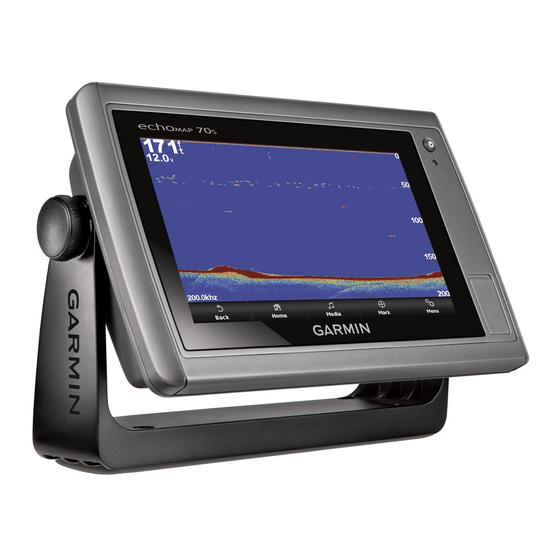High Resolution Satellite Imagery: Provides high-resolution
satellite images for a realistic view of the land and water on
the Navigation chart
(Showing Satellite Imagery on the
Navigation
Chart).
Aerial Photos: Shows marinas and other navigationally
significant aerial photos to help you visualize your
surroundings
(Viewing Aerial Photos of
Detailed Roads and POI data: Shows detailed road and point
of interest (POI) data, which includes highly detailed coastal
roads and POIs such as restaurants, lodging, and local
attractions.
Auto Guidance: Uses specified safe depth, safe height, and
chart data to determine the best course to your destination.
Auto Guidance is available when you navigate to a
destination using Guide To.
Viewing Tide Station Information
on the chart indicates a tide station. You can view a detailed
graph for a tide station to help predict the tide level at different
times or on different days.
NOTE: This feature is available with premium charts, in some
areas.
1
From the Navigation chart or Fishing chart, select a tide
station.
Tide direction and tide level information appear near
2
Select an option to view additional station information:
• Select the station name.
• If more than one item is in the vicinity, select Review, and
select the station name.
Animated Tide and Current Indicators
NOTE: This feature is available with premium charts, in some
areas.
You can view indicators for animated tide station and current
direction on the Navigation chart or the Fishing chart. You must
also enable animated icons in the chart settings
Configuring Tides and
Currents).
An indicator for a tide station appears on the chart as a vertical
bar graph with an arrow. A red arrow pointing downward
indicates a falling tide, and a blue arrow pointing upward
indicates a rising tide. When you move the cursor over the tide
station indicator, the height of the tide at the station appears
above the station indicator.
Current direction indicators appear as arrows on the chart. The
direction of each arrow indicates the direction of the current at a
specific location on the chart. The color of the current arrow
indicates the range of speed for the current at that location.
When you move the cursor over the current direction indicator,
the specific current speed at the location appears above the
direction indicator.
Color
Current Speed Range
Yellow
0 to 1 knot
Orange
1 to 2 knots
Red
2 or more knots
Showing and Configuring Tides and Currents
NOTE: This feature is available with premium charts, in some
areas.
You can show static or animated tide and current station
indicators on the Navigation chart or Fishing chart.
1
From the Navigation or Fishing chart, select Menu > Chart
Setup > Tides & Currents.
2
Select an option:
• To show current station indicators and tide station
indicators on the chart, select On.
Charts and 3D Chart Views
Showing Satellite Imagery on the Navigation Chart
NOTE: This feature is available with premium charts, in some
areas.
Landmarks).
You can overlay high-resolution satellite images on the land or
on both land and sea portions of the Navigation chart.
NOTE: When enabled, high-resolution satellite images are
present only at lower zoom levels. If you cannot see high-
resolution images in your optional chart region, you can select
changing the map zoom detail.
1
2
Viewing Aerial Photos of Landmarks
.
Before you can view aerial photos on the Navigation chart, you
must turn on the Photo setting in the chart setup.
NOTE: This feature is available with premium charts, in some
areas.
You can use aerial photographs of landmarks, marinas, and
harbors to help orient yourself to your surroundings or to
acquaint yourself with a marina or a harbor prior to arrival.
1
(Showing and
2
Automatic Identification System
The Automatic Identification System (AIS) enables you to
identify and track other vessels, and alerts you to area traffic.
When connected to an external AIS device, the chartplotter can
show some AIS information about other vessels that are within
range, that are equipped with a transponder, and that are
actively transmitting AIS information.
The information reported for each vessel includes the Maritime
Mobile Service Identity (MMSI), location, GPS speed, GPS
heading, time that has elapsed since the last position of the
vessel was reported, nearest approach, and time to the nearest
approach.
Some chartplotter models also support Blue Force Tracking.
Vessels being tracked with Blue Force Tracking are indicated
on the chartplotter with a blue-green color.
AIS Targeting Symbols
Symbol Description
• To show animated tide station indicators and animated
current direction indicators on the chart, select Animated.
to zoom in. You also can set the detail level higher by
From the Navigation chart, select Menu > Chart Setup >
Satellite Photos.
Select an option:
• Select Land Only to show standard chart information on
the water, with photos overlaying the land.
• Select Photo Map Blend to show photos on both the
water and the land at a specified opacity. Use the slider
bar to adjust the photo opacity. The higher you set the
percentage, the more the satellite photos cover both land
and water.
From the Navigation chart, select a camera icon:
• To view an overhead photo, select
• To view a perspective photo, select
taken from the location of the camera, pointed in the
direction of the cone.
Select Review > Aerial Photo.
AIS vessel. The vessel is reporting AIS information. The
direction in which the triangle is pointing indicates the
direction in which the AIS vessel is moving.
Target is selected.
.
. The photo was
5

